Willkommen: Hier finden Sie die deutsche Version unseres Briefes aus Berlin! Welcome to our Letter from Berlin! This week we continue to focus on new projects and re-opening exhibitions. On occasion of Angela Bulloch’s exhibition with Gerwald Rockenschaub Festival!, we introduce her collaboration with David Grubbs The Wired Salutation with an excerpt from Grubbs essay. This coming Sunday, June 21, the gallery will be open as part of SUNDAY OPEN, as we also continue participating in the now extended Basel by Berlin. Please visit our new Online Viewing Room for PS81E and the presentation of our Art Basel Online Viewing Room. We want to draw your attention to exhibitions with Simon Fujiwara and Roman Ondak opening next week in Bonn and Aalborg, respectively, and also take a closer look at their works in our exhibition PS81E.Anything you may have missed from our social media channels can be found on Continuity, our digital platform. Read this in good health.
|
|
|
Angela Bulloch and David Grubbs – The Wired Salutation
|
|

| Angela Bulloch and David Grubbs, The Wired Salutation, performance / concert at Theater der Künste in Zurich, Switzerland on February 18, 2016. Video © Heinrich Schmidt, © Vernissage TV (This is a Youtube link.)
| |
|
To introduce The Wired Salutation and as additional context for Angela Bulloch's presentation as part of Festival!, we excerpt from an essay by David Grubbs, first published in Angela Bulloch's 2019 monograph Euclid in Europe, 2019.
Toggle Ensemble
by David Grubbs
The large screen at the front of the stage contains the still image of a pattern of interlocking polygons whose volume is suggested by three shades of blue. There’s still time to find your seat.
The pattern—and its presence here in the theater—announces “curtain,” but the eye is tempted to read the warp within the image as representing depth. The distortion in the pattern in the lower half of the image causes it to spread out before us as ground—a space to enter into, to project oneself into, a ground or floor or stage to stand upon, and upon which to place objects. Into which to accrue objects. To fill. At an indeterminate distance the pattern decisively curves upward as wall, as back wall and visible limit. A vertiginous tilt toward downstage left suggests that the axis is skewed, that crossing upstage on a diagonal is an uphill trek, so be careful where you place those props. The pattern duck-rabbits between flatness and depth, between curtain and stage, between zigzagging blue filigree composition and disorienting space of performance much as the ranks of polygons within the nominally still image flip this way and that. Four unhurried stick clicks set the tempo, and on the downbeat avatars of four musicians fade in atop the pattern of polygons. An unseen live ensemble with drum kit and twinned electric guitars loops a syncopated shuffle and a buttonhook of a melody whose upward turn suggests a persistent unanswered question. The four avatars swivel and groove in a style that’s uniquely their own. Don’t look away. They’re here to accompany the music played by the hidden group, or perhaps it’s the invisible musicians who accompany the avatars. In either case
it toggles. A virtual camera zooms in on the avatar quartet of—from left to right—guitarist one, mustachioed drummer, guitarist two, and an electric bassist who resembles Angela Bulloch. It’s a virtual multi-camera shoot, with one angle cross-fading into the next, from full-group establishing shot to individual close-ups, and from a slow right-to-left pan across the group to an overhead tracking shot. The overheard shot strafes, a perspective reminiscent of remote-control high-wire cameras at sporting events. The warped polygons continue to pose all manner of riddles of spatial representation and
here the avatars will not be rushed. They swim along at their own tempo. The virtual performers are more or less in sync with one another, whether or not they ever appear convincingly synchronized with the music that they’re supposed to be playing, that they accompany and that accompanies them. The music is an instrumental composition, thankfully, so there’s no demand for the certain-to-fail challenge of lip-synching. Before long they’re as out of sync with the musical performance as the earliest lip-synching artists half a century ago on live television, pantomimes that concluded with performers unable to keep a straight face, swapping instruments, goofing, falling
all over themselves. The avatars betray no anxiety about whether or not their pantomime passes. They have zero problem keeping four straight faces, and it’s hard to imagine them laughing, lipsynching laughter. Busting a virtual gut. Their gestures are attenuated, soft, serious. A little stoned. Their method is doctrinaire doing-it-easy. The drummer gently flails, and there’s never even the semblance of stick striking drum or cymbal. He paddles away slowly and steadily, shadow-drumming or air-drumming with one hand gesturing toward a floor tom, the other aimed at a shallow rack tom, and the sticks land inches shy of their ostensible targets. The implements—not drumsticks exactly—more closely resemble retractable metal pointers or snapped-off automobile antennas, and even with his fierce unblinking eyes the drummer avatar fools no one. Meanwhile, the two guitarist avatars have mastered the weird feat of playing without guitar straps. The guitars simply float. Occasionally, one of the guitarist avatars turns at an angle such that the image glitches and for an instant the instrument becomes transparent.
The audience sees the avatars up close.
The audience sees the avatars at twice human scale.
The avatars impress as something not designed to be brought so close
nor intended to be viewed at such a scale. They appear as something neither to be studied at such proximity nor uninterruptedly. Still, don’t look away. Flash back to a celebrated electronic pop group and their first use of robots onstage, in which the entirety of the concert led to the promised appearance of the robots—to the band’s replacement by robots—which happens only in its final moments. The crowd goes completely bananas, even as the robots are distant and small and positioned at the rear of the stage; it’s a mechanical puppet show, and a knowingly brief one. The robots’ designers must have been concerned that they not overstay their welcome. (The audience roars most loudly when the four robots spin 360 degrees on a steel axle.
(continued)
The full text can be found in Angela Bulloch, Euclid in Europe, published by Hatje Cantz in 2019. See below for ordering information.
|
|
|
Festival! #1 – Angela Bulloch | Gerwald Rockenschaub |
|
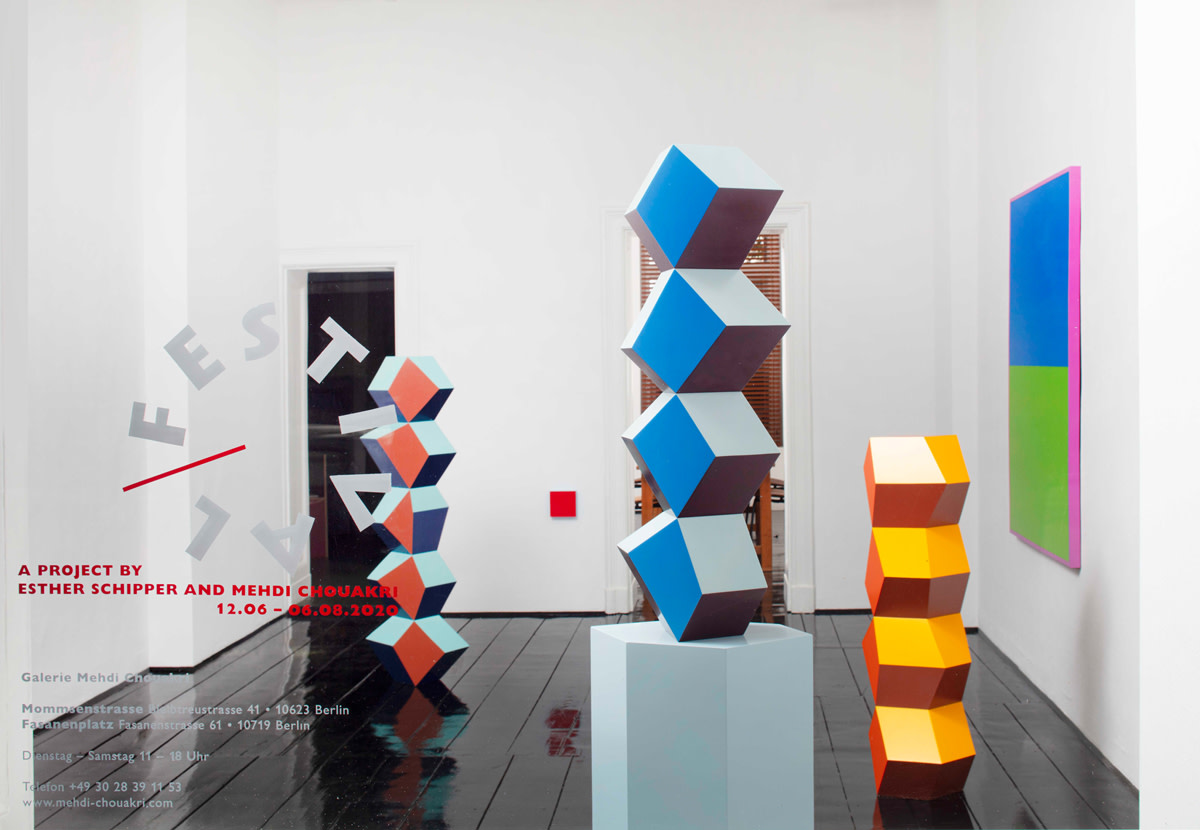
| Exhibition view: Festival! A Project by Esther Schipper and Mehdi Chouakri, Mehdi Chouakri, Berlin, 2020
Photo © Ludger Paffrath⠀ | |
|
FESTIVAL!
A project by Esther Schipper and Mehdi Chouakri
Mehdi Chouakri, entrance: Mommsenstrasse 4, D–10623 Berlin
New exhibition bi-weekly
June 12 – August 6, 2020
Angela Bulloch | Gerwald Rockenschaub, through June 25
Isa Melsheimer | N. Dash, from June 27
Anri Sala | Saâdane Afif
Ari Benjamin Meyers | Charlotte Posenenske
Festival! at Mehdi Chouakri Mommsenstrasse will be open on Sunday, June 21 from 11 am though 5 pm as part of SUNDAY OPEN.
The first pair is Angela Bulloch with Gerwald Rockenschaub. The artists, who have exhibited together in the past, could be said to share a formal vocabulary informed by both minimalism and the digital. Angela Bulloch analyses and challenges the structures defining our social behaviours, with a sustained conceptual approach. Her work spans many media, manifesting her interest in systems, patterns and rules, as well as her preoccupation with the history of shapes and human interaction. The recent series of sculptures combines her interest in the logic of geometry and seriality with a graphic quality.
Initially known as part of the so-called Neo-Geo movement emerging in the early 1980s, Rockenschaub’s unorthodox approach to ingrained visual expectations is essential to his approach—he continuously seeks to thwart these in subtle, technically precise ways. The distinct proximity of his colours, shapes, and above all his artificial, synthetic materials to the world of product design is as familiar as it is alienating. |
|
|

| Exhibition view: PS81E, Esther Schipper, Berlin, 2020
Photo © Andrea Rossetti
| |
|
PS81E
with works by Stefan Bertalan, Martin Boyce, Matti Braun, AA Bronson and Reima Hirvonen, Angela Bulloch, Nathan Carter, Etienne Chambaud, Jean-Pascal Flavien, Ceal Floyer, Simon Fujiwara, Ryan Gander, General Idea, Francesco Gennari, Liam Gillick, Andrew Grassie, Ann Veronica Janssens, Gabriel Kuri, Jac Leirner, Ari Benjamin Meyers, Roman Ondak, Philippe Parreno, Ugo Rondinone, Christopher Roth, Anri Sala, Karin Sander, Julia Scher, Daniel Steegmann Mangrané, Tao Hui
June 16 - July 25, 2020
We are pleased to participate in SUNDAY OPEN, initiated by INDEX Berlin. Our exhibition will be open this Sunday, June 21, from 11 am through 5 pm.
We are also pleased to participate, together with 31 Berlin-based galleries, in Basel by Berlin: an analog counterpart to Art Basel's Online Viewing Rooms, which has been extended through Sunday, June 21, 2020.
In a normal year we would be at Art Basel right now. We curated an extraordinary booth for this year’s fair, selecting major works and producing many new ones. Crated and shipped from around the world, the booth installed in three full days, our team would be ready to greet you. As doors would open and visitors rush in, time would become elastic: a million short encounters compressed into these hours.
Instead we have installed these works in our Berlin gallery. To some extent, this is an anti-fair: with certain social distancing requirements in place, there will be ample space and plenty of time to engage with each visitor. While access may be limited at times, time is not. With our exhibition PS81E we acknowledge the irreplaceable experience of encountering an artwork in person. We take this as an opportunity.
It begins when you enter: Julia Scher’s historical work Occupational Placement greets visitors in the main entrance hall, with Christopher Roth’s bright red sign space-time.tv announcing his ongoing project presented in the bookstore last summer, as to the left Ugo Rondinone’s bronzes from his 2016 series Primordial hang suspended, while Ari Benjamin Meyers Duet invites a visitor to learn a song, close to Jean Pascal Flavien's greenhouse.
|
|
|
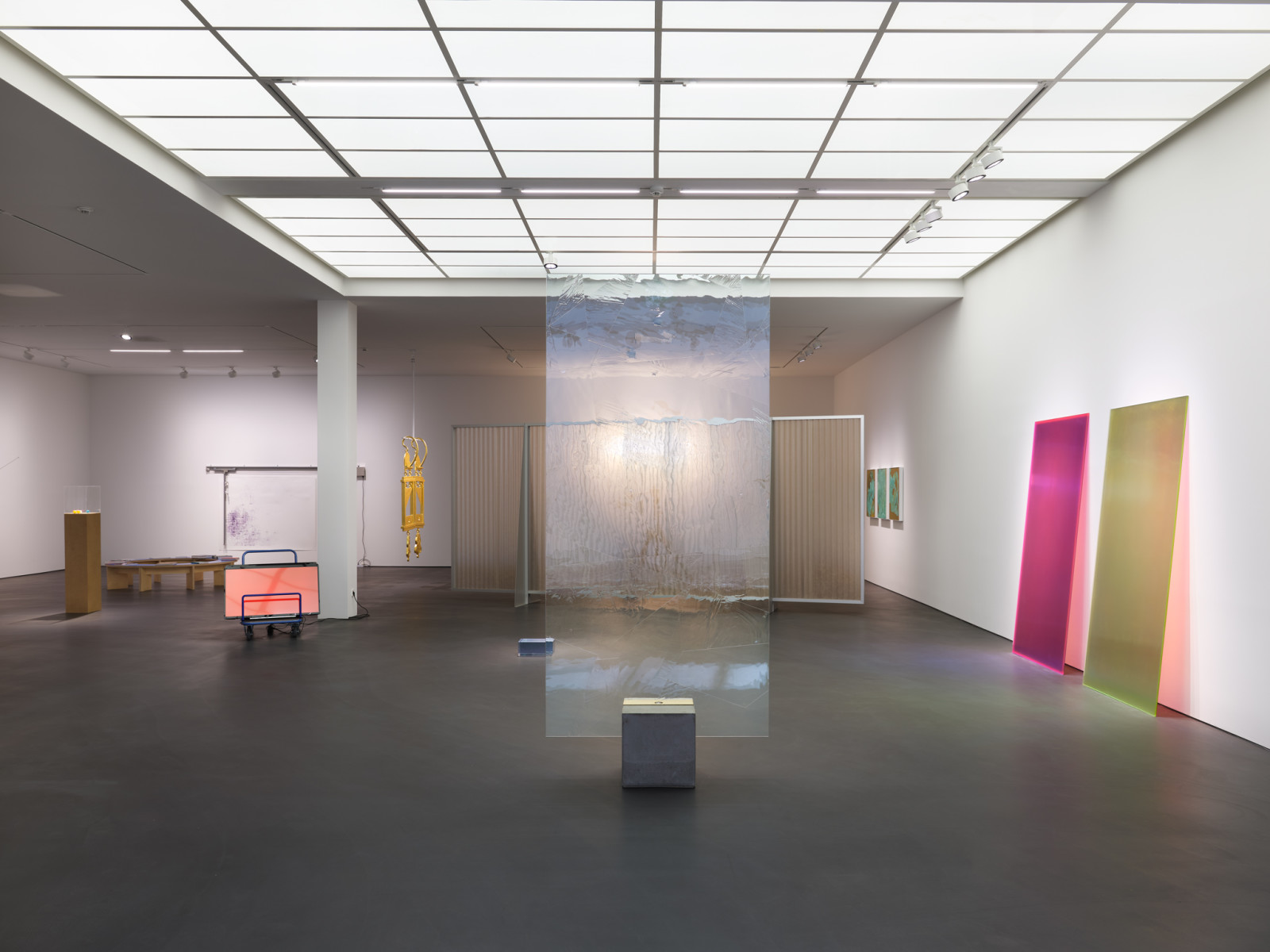
| Exhibition view: PS81E, Esther Schipper, Berlin, 2020
Photo © Jörg von Bruchhausen
| |
|
The central exhibition space is punctuated by two large diaphanous screens by Martin Boyce. Ann Veronica Janssens iridescent diptych, silk works by Matti Braun in deeply saturated colors, Nathan Carter’s playful “intersexual” collages, and Daniel Steemann Mangranés glass Systemic Grid 124 frame sculptures by Gabriel Kuri and Francesco Gennari. Karin Sander’s colorful polished ping-pong balls, Anri Sala’s cinematic snail etched into a wooden textile stamp, and Ceal Floyer’s wry and witty work of facing loudspeakers, Mutual Admiration, meet below a new transparent marquee by Philippe Parreno. We welcome artists who have more recently joined the gallery: Jac Leirner with the sculpture Jewel, steel cables attached to one another according to their diminishing thickness, Etienne Chambaud panels from his series Nameless, produced with the urine of wild animals, and Tao Hui’s multiple monitors assembled for Screen as Display Body.
A historical work by Liam Gillick invites you to sit and watch the new dynamic drawing machine by Angela Bulloch, as Simon Fujiwara’s enlarged earrings with the guillotined heads of the French monarchs hang suspended near Stefan Bertalan’s geometric drawing from the early 1970s and Sunset by Andrew Grassie, while someone or something is making away with a fistful of currency in Ryan Gander’s I'm never coming back to London again.
|
|
|

| Exhibition views: PS81E, Esther Schipper, Berlin, 2020
Photo © Andrea Rossetti
| |
|
From a Plexiglas case two small dolls, AA Bronson and his husband, produced by the artist in collaboration with Reima Hirvonen, look out, across to a historical work by General Idea, the 1976 Search for the Spirit, and to Roman Ondak’s 1997 Sated Table, an assembly of household goods and philosopher-ingredients.
We look forward to your visit in our gallery to view in Berlin what might have been Art Basel 2020 but now is PS81E.
|
|
|
PS81E Online Viewing Room |
|
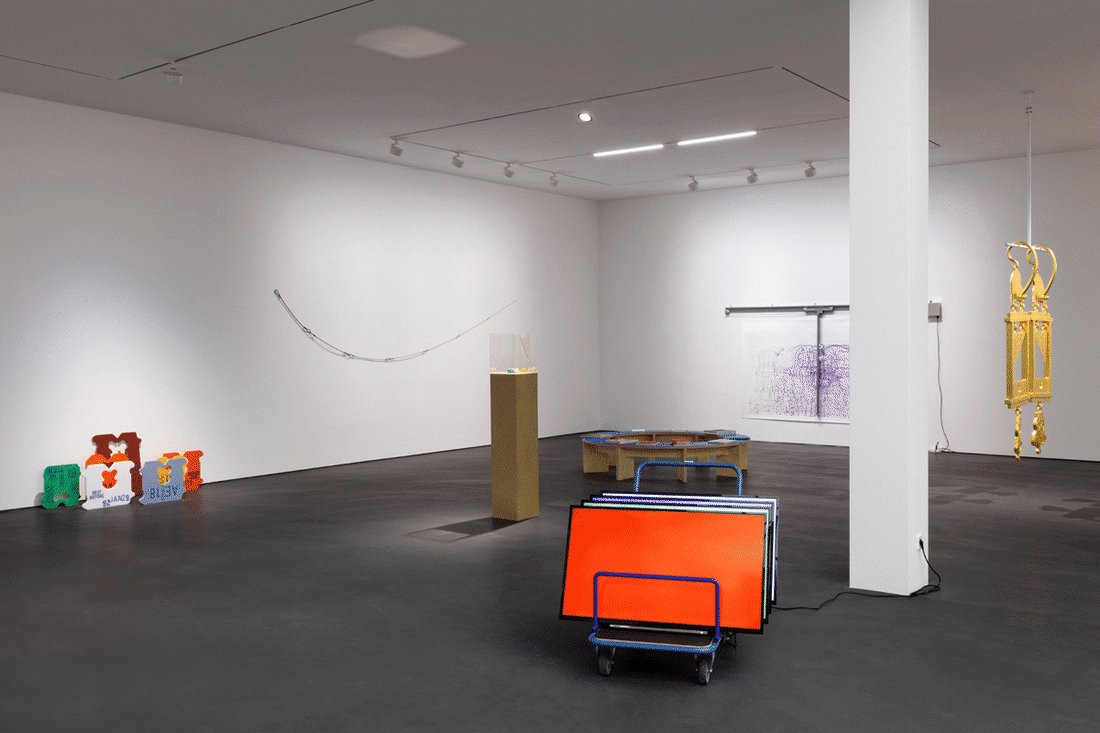
| Exhibition views: PS81E, Esther Schipper, Berlin, 2020
Photos © Andrea Rossetti & Jörg von Bruchhausen
| |
|
PS81Ewith works by Stefan Bertalan, Martin Boyce, Matti Braun, AA Bronson and Reima Hirvonen, Angela Bulloch, Nathan Carter, Etienne Chambaud, Jean-Pascal Flavien, Ceal Floyer, Simon Fujiwara, Ryan Gander, General Idea, Francesco Gennari, Liam Gillick, Andrew Grassie, Ann Veronica Janssens, Gabriel Kuri, Jac Leirner, Ari Benjamin Meyers, Roman Ondak, Philippe Parreno, Ugo Rondinone, Christopher Roth, Anri Sala, Karin Sander, Julia Scher, Daniel Steegmann Mangrané, Tao Hui To find out more about the works in the exhibition visit our Online Viewing Room: See inside the exhibition
|
|
|
Art Basel Online Viewing Room |
|
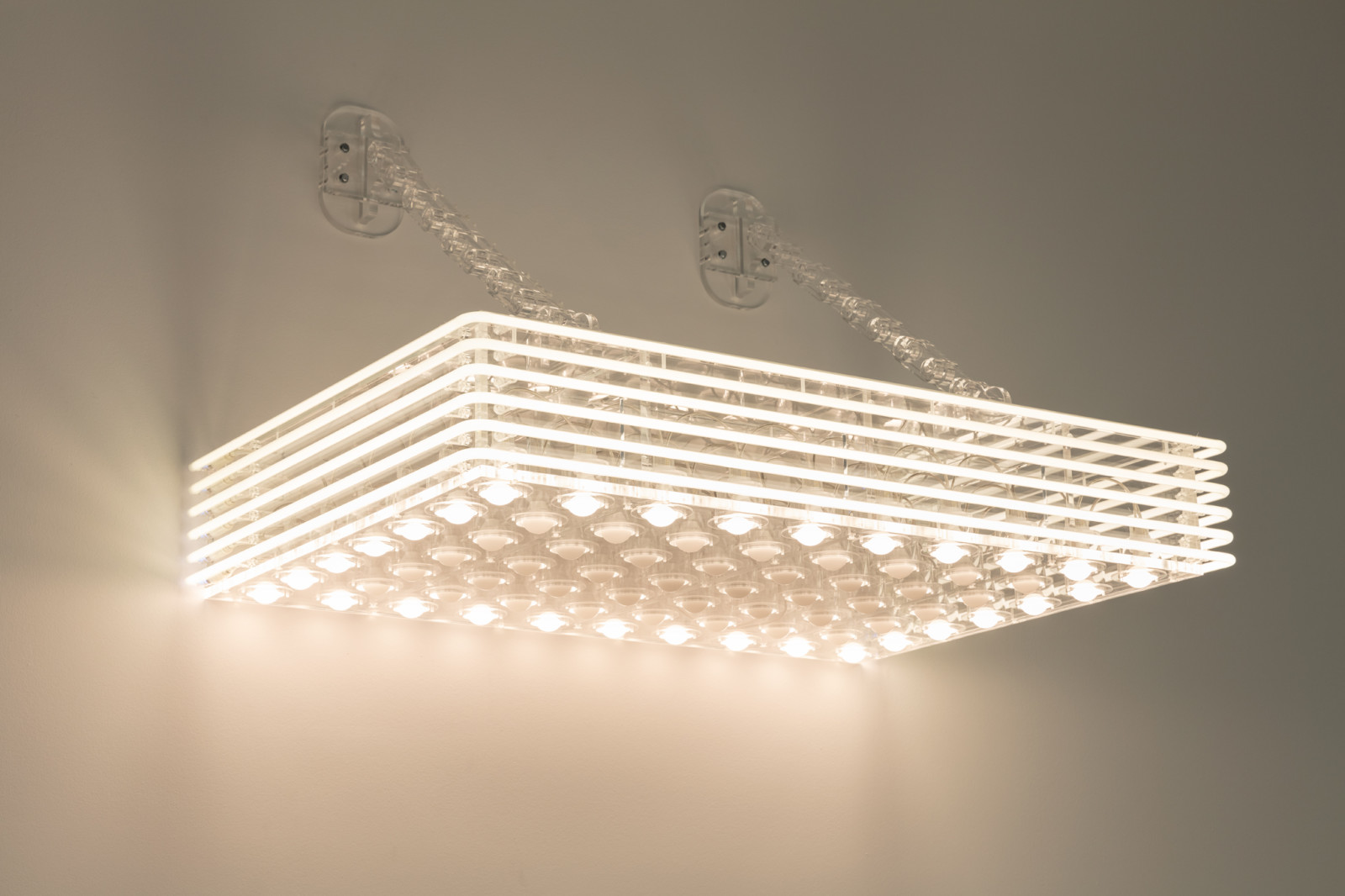 | Philippe Parreno, Marquee, 2020, transparent Plexiglas, 70 white bulbs, 6 white neon tubes (ø 10 mm), DMX recorder, dimmers, light program, transparent acrylic chains, 74,3 x 123 x 81 cm
Photo © Andrea Rossetti | |
|
Art Basel
Online Viewing Room June 17 – 26, 2020 Online Now
Esther Schipper is delighted to announce our participation in Art Basel’s second iteration of Online Viewing Rooms, a digital platform designed to connect galleries and collectors from around the world. Our Art Basel Online Viewing Room features works by Stefan Bertalan, Matti Braun, AA Bronson and Reima Hirvonen, Angela Bulloch, Etienne Chambaud, Simon Fujiwara, Ryan Gander, General Idea, Ann Veronica Janssens, Gabriel Kuri, Roman Ondak, Philippe Parreno, Ugo Rondinone, Anri Sala, Karin Sander.Explore the Art Basel Online Viewing Room HERE.
|
|
|
Simon Fujiwara – State of the Arts, Bundeskunsthalle, Bonn
|
|
 | Simon Fujiwara, Empathy I, 2018, 5D simulator installation (with video, sound, motion, water, and wind), duration 3:49 min, outer dimensions of box: 3,71 x 7,6 x 5,35 meters
Exhibition view: Simon Fujiwara, Empathy I, Esther Schipper, Berlin, 2018
Photo © Andrea Rossetti | |
|
On June 26 Simon Fujiwara's 5D simulator installation Empathy I will open to the public at the Bundeskunsthalle in Bonn as part of the group exhibition State of the Arts.
The work, which was first exhibited at the gallery in Berlin, subsequently exhibited at Lafayette Anticipations, Paris, The Shed, New York and will now be on view in Bonn through August 16, 2020.
The artist’s starting point in conceiving Empathy I was to create a physical simulation of the ‘real world’ using theme park technology commonly used to create fantasy and escapist experiences. In close collaboration with a theme park manufacturer he began to develop his own 5D motion simulator that immerses audiences in a hyper-real and intensely physical experience by combining video, sound, wind, water and moving seating. In Fujiwara’s ride, audiences embark on a journey where they briefly embody a series of ‘other people’s lives’ through a rapidly changing series of Youtube clips shot in first person camera perspective. A bride at her own wedding, saving a man stranded at sea, a woman at a roadside fight, driving and partying with friends through the Middle Eastern desert or exiting a train in an electric wheelchair - audiences experience not only the visual but the physical aspects of these intimate realms, strapped into seating that moves in precise synchronism with the movements of the various handheld cameras.
Experienced in a starkly designed metal ‘box’ by only two people at a time, visitors wait in a specially designed waiting area before being guided through the experience by a trained attendant. For the artist, the public act of waiting and the intimate and extreme physical experience inside the room are placed in contrast inviting questions about the role and value of the body, time and experience in an increasingly mechanized world.
Once inside, the work takes the audience to the limits of the body’s biological capacities forcing viewers to experience danger, stillness, speed, sadness and pleasure in just under four minutes - a theme park industry standard time before motion sickness or dysphoria sets in. In an age of mass media and screen fatigue, Fujiwara radically shifts the focus from image consumption to bodily experience, describing the work as a ‘sculptural experience’ that places the audience’s own feelings at the center of the work. In the range of videos he sources and edits, viewers experience a hyper-emotional world through bodies that are other to themselves in respect to race, physical ability, gender, class etc. It asks us to reflect on the ethics of representation, simulation and empathy production in our increasingly technological environment - at once thrillingly emotive and disturbingly controlled.
|
|
|
 | Simon Fujiwara, Empathy I, 2018, 5D simulator installation (with video, sound, motion, water, and wind), duration 3:49 min, outer dimensions of box: 3,71 x 7,6 x 5,35 meters
Exhibition view: Manual Override, The Shed, New York, 2019 – 2020
Photo © Scott Rudd
| |
|
Simon Fujiwara – Interview Collectors Agenda
|
|

| Courtesy of Collectors Agenda
Photo © Kristin Loschert | |
|
This week the art magazine Collectors Agenda published an extinsive interview with Simon Fujiwara. Below excerpts from their conversation in which Simon also spoke about his fascination for female characters, among them Marie Antoinette who is the subject of his work currently on view as part of PS81E, A Dramatically Enlarged Set of Golden Guillotine Earrings Depicting the Severed Heads of Marie Antoinette and King Louis XVI, 2019.
Your art is very diverse, your practice is both performative and interdisciplinary. You combine various disciplines and media in your work. How would you describe the art you make in your own words?
I never begin with the question of what medium will be, but rather what it is that I want to explore and how best to communicate that, then the issue of media comes into consideration. My work is visually all over the place and inhabits many aesthetics as a consequence of being made in the world now, where ‘collage-like’ and often colliding aesthetics are normal not just in art, or online but in everyday life. This can be about the material world we inhabit and the collage of values they embody – luxury meets the recycled/sustainable, information or news is presented as entertainment etc. There is more diversity, our digital encounters are more global, on any given day we are confronted with the possibility of multiple realities which was not the case even as recently as a decade ago. This is how my world looks – diverse, confusing, exciting, incomprehensible, fearful – and I can only make work that is close to my experience. It’s not a conceptual approach.
(….)
It sounds as if you see yourself as a political artist, do I understand that correctly?
I feel very responsible to my time and work as clear-sightedly as I can to record, document, transform, mirror, or distort it. You can call it political if you like, I don’t care so much for that terminology. My primary care is people. I care deeply about the audience.
|
|
|
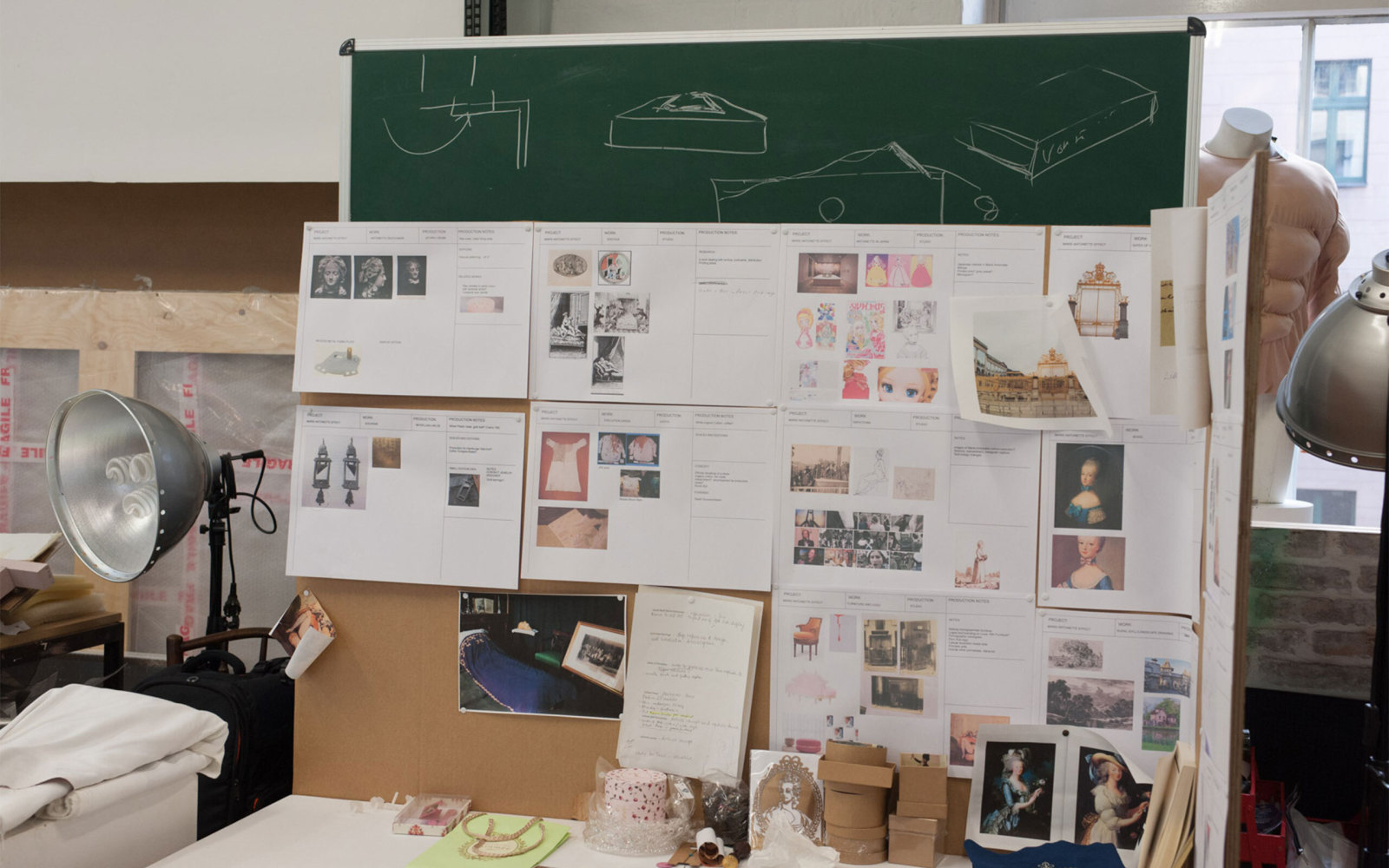 | Courtesy of Collectors Agenda
Photo © Kristin Loschert | |
|
In your artistic work you have dealt with the biographies of other women, too, like Marie Antoinette, your former teacher Joanne, and Angela Merkel. Is there something that connects these works in addition to the fact that they are all about women? I’m obviously obsessed with women. I could give you a pop psychology answer like “I was raised by a single mother or I’m gay.” That would be the easy answer. Historically, women have occupied a more interesting position than men for me because they have had to fight to change their status from object or property to human beings with their own rights. In this fight they have revealed so much about humanity. It interests me because now, through social media, many humans are willingly re-objectifying themselves again by seeking to become brands in their own right and therefore become tradeable, consumable commodities. When once a child would dream of being an astronaut, now some dream of being an influencer. I can totally understand that desire, where the everyday actions in one’s life from drinking a coffee at a café to meeting friends can become marketable experiences and therefore have some kind of meaning, through capitalist benefits or in the act of documenting and affirming one’s life experience. The full interview with Simon Fujiwara by the art magazine Collectors Agenda can be read HERE.
|
|
|
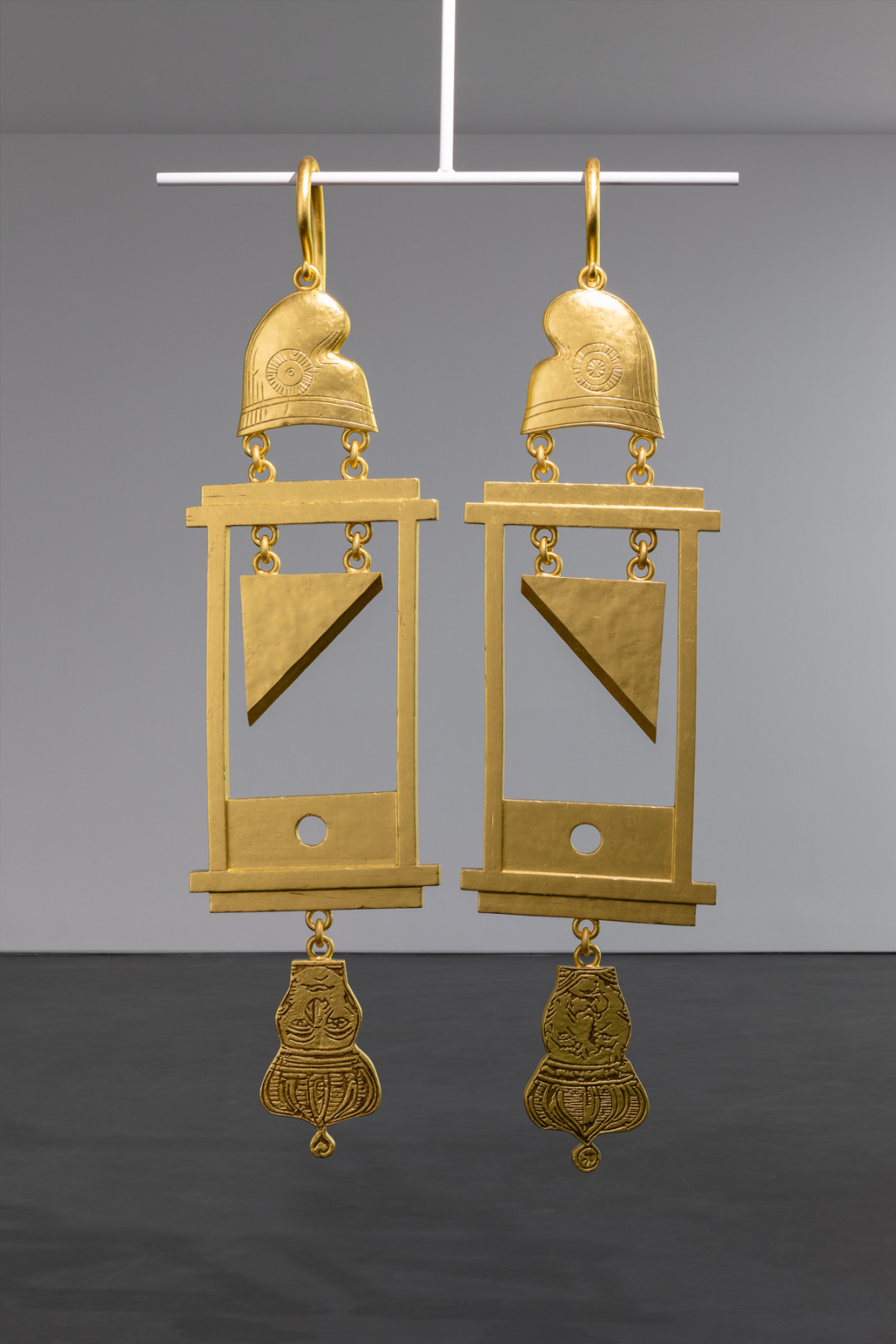
| Simon Fujiwara, A Dramatically Enlarged Set of Golden Guillotine Earrings Depicting the Severed Heads of Marie Antoinette and King Louis XVI, 2019, rigid foam, aluminum, gold leaf,208 x 52,5 x 27 cm each (2 parts)
Photo © Andrea Rossetti | |
|
The point of departure for Simon Fujiwara's sculpture in our current exhibition PS81E is a pair of earrings in the shape of two guillotines with the heads of Queen Marie-Antoinette and King Louis XVI hanging from them; the earrings are believed to be made and sold around the time of the French Revolution. Fujiwara has digitally reproduced and enlarged the earrings to create a monumental sculpture printed in 3D and hand-gilded in 23K gold. As Simon Fujiwara noted “The work connects deeply to my ongoing study of human-product-object relations, and the commodification of ‘everything’ that is reaching a peak today. They are a gruesome but glorious reminder of the ways human capitalize and reinvent almost any kind of event but they are also a celebration of the human ingenuity to convert everything into some form of object or celebration, in this case, the perversity of celebrating the fall of a kingdom that was plagued by excess and overspending by making gold earrings."
More information on the work can be found in our PS81E Online Viewing Room.
|
|
|
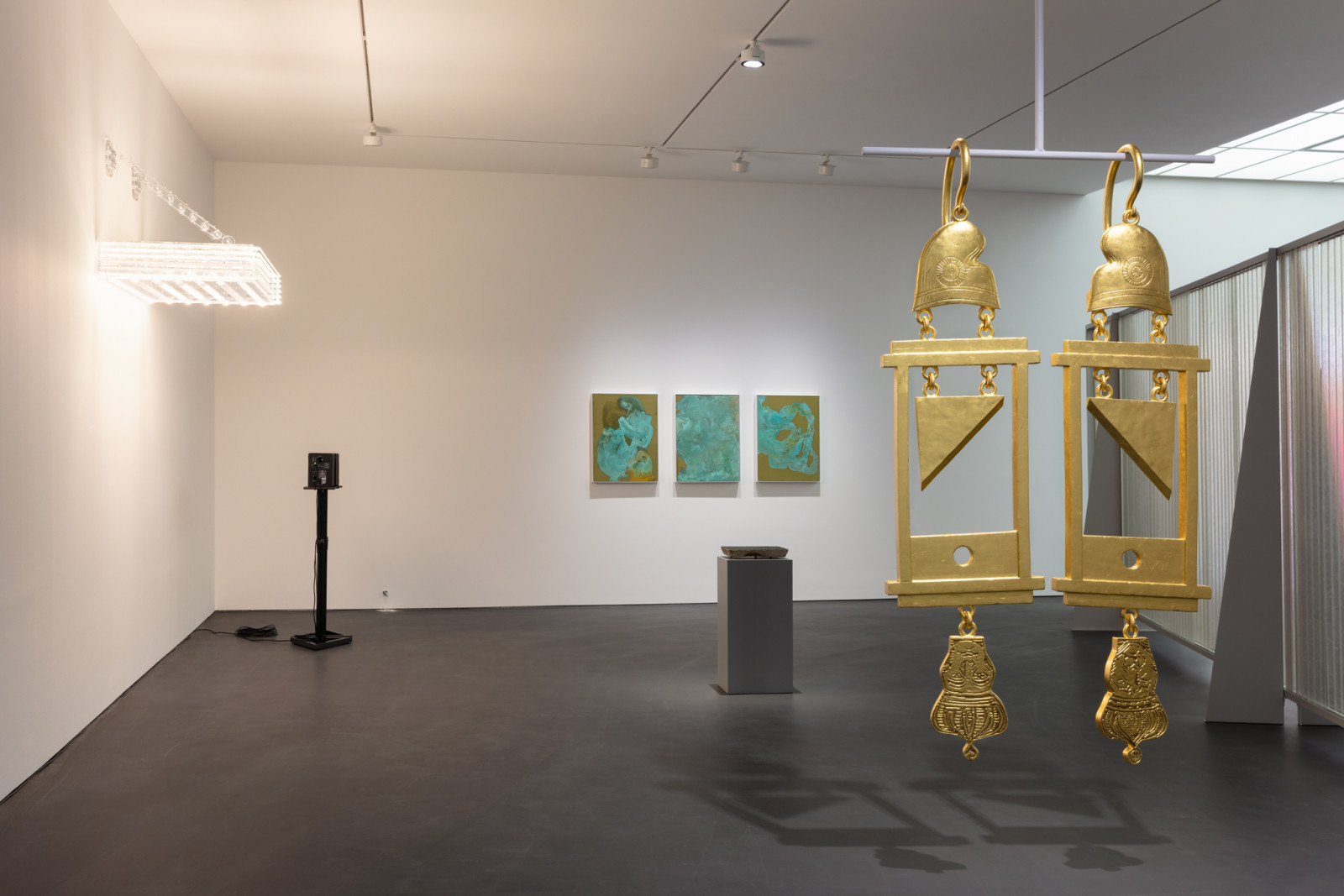
| Exhibition views: PS81E, Esther Schipper, Berlin, 2020
Photo © Andrea Rossetti | |
|
Roman Ondak – Landscape, Kunsten Museum of Modern Art, Aalborg
|
|
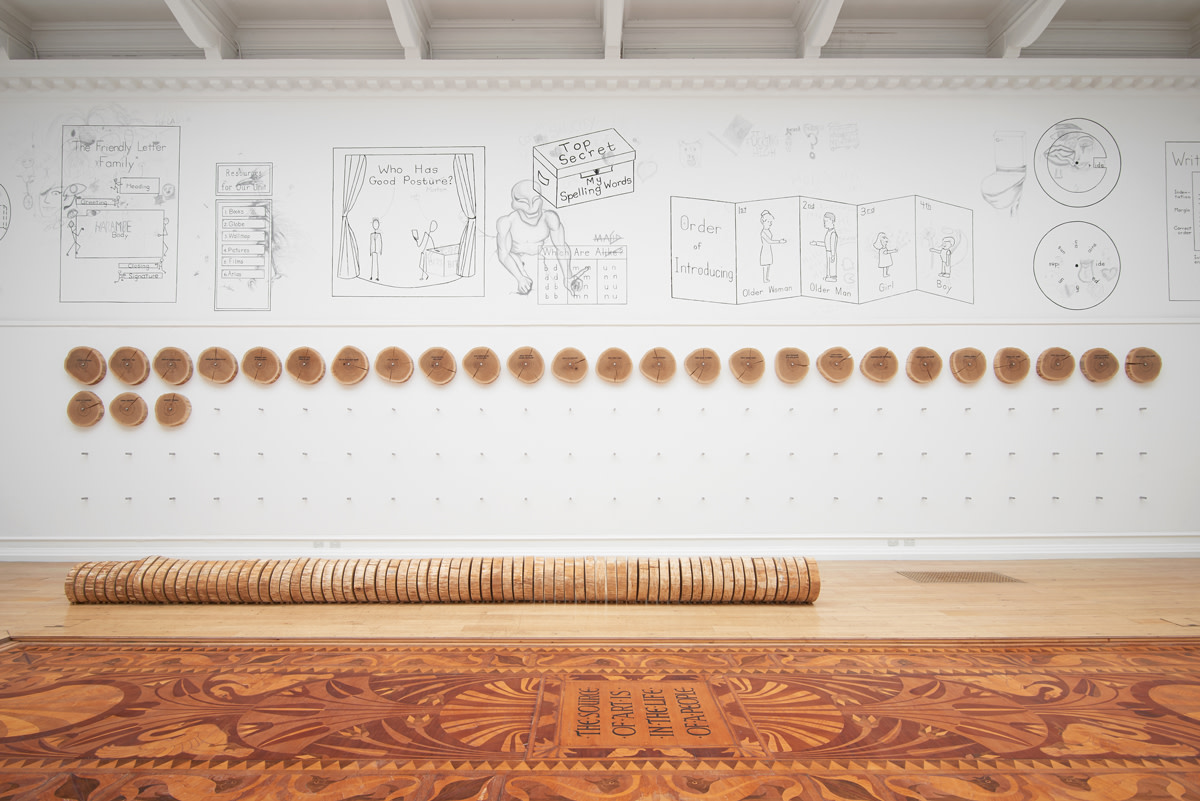 | Roman Ondak, Event Horizon, 2016, oak tree, stamped ink, acrylic paint, steel fixtures, dimensions variable
Exhibition view: Roman Ondak, The Source of Art is in the Life of a People, South London Gallery, London, 2016 –2017
Photo © Andy Keate
| |
|
On June 26, 2020 Kunsten Museum of Modern Art in the Danish city Aalborg opens Landscape, a broadly conceived exhibition spanning works from the 19th century to the present day. As the organizers write, the exhibition presents a comprehensive selection of works from many different periods and with many different forms of expression: ranging from empathetic to temperamental landscapes, and from conceptual to quite simply beautiful landscapes. The exhibition also presents a new acquisition. Roman Ondak’s Event Horizon (2016), is being shown in Denmark for the very first time. The work places nature, time and the history of humankind in a larger context and features a single oak tree cut up into 100 pieces. Each piece represents a single year and an historic event from that year.
|
|
|
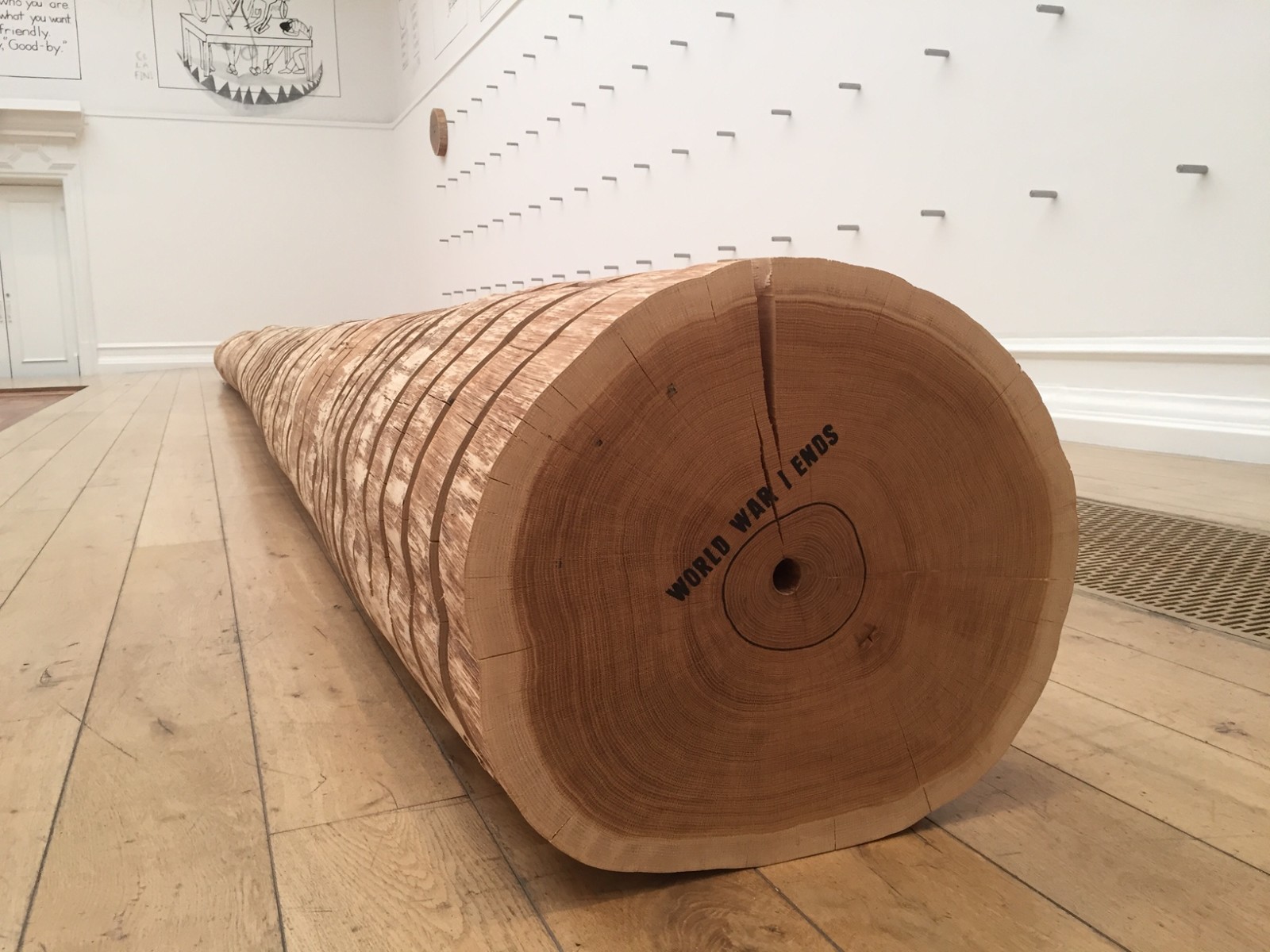 | Roman Ondak, Event Horizon, 2016, (detail) oak tree, stamped ink, acrylic paint, steel fixtures, dimensions variable
Exhibition view: Roman Ondak, The Source of Art is in the Life of a People, South London Gallery, London, 2016 –2017
Photo © Andy Keate | |
|
First presented at the South London Gallery in London in 2016, Event Horizon is a sculptural installation with a processual component. Symbolizing a period of a hundred years, the work consists of 100 wooden discs from a 130 years old oak tree and 100 pegs on which the pre-sawed discs are gradually placed, one every passing day. On each disk one of its growth rings is marked with ink and paired with a named historical event. Among these are wars, treaties, scientific breakthroughs and events relating to historical figures. Some of the occurrences are well known and easily dated, for example, the end of World War I, others more specialized, as for example, the year in which the first successful heart transplant was performed: 1967. The artist’s inevitably subjective selection of events to highlight exposes the impossibility of an objective, unbiased history, as well as the impact of the teaching on our understanding and interpretation of the past. Gradually evolving over the course of the exhibition, as the oak tree is incrementally transferred from floor to wall, the sculpture creates a notional calendar that links the passing of days to the much larger increments of time—and history—symbolized by the markings on its disks.
Roman Ondak's work often evolves from a performative conception thus Sated Table, currently on view as part of PS81E, can be traced to an earlier work with an overtly performative component. |
|
|
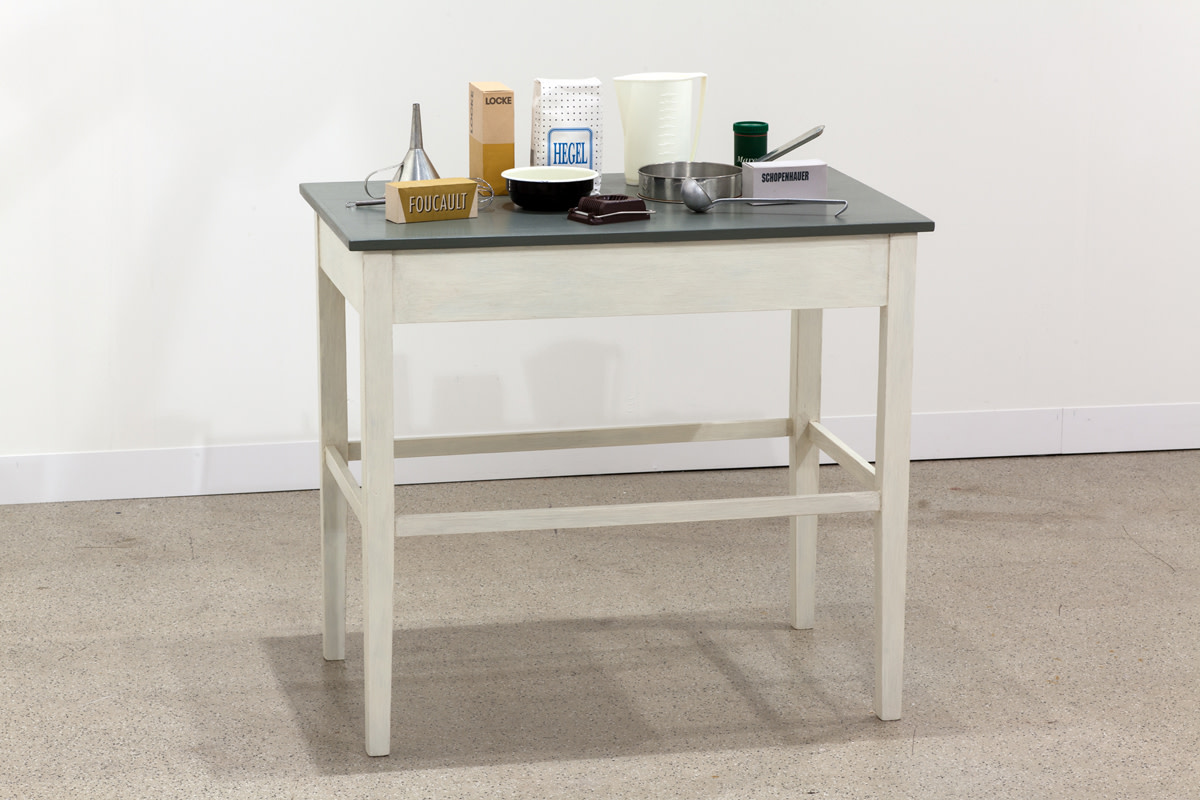
| Roman Ondak, Sated Table, 1997, silkscreen print on cardboard, kitchen utensils, wooden table, 100 x 92 x 59 cm
Photo © Simon Vogel
| |
|
Dating from 1997, Sated Table is an important early work by Roman Ondak. Cooking utensils and ingredients are laid out on a table, as though ready to use. Among the objects are a whisk, a ladle, a bowl, a measuring jug and a sieve. Because of this, the packets of food sitting beside them on the dark grey table surface at first glance look to be the ingredients for making a cake, such as butter, flour and sugar. But the brand names on their packages have been exchanged with those of the well-known philosophers Foucault, Locke, Hegel, and Schopenhauer. One package, labelled Marcel, is more mysterious: it refers to the French philosopher, drama critic, playwright and musician, Gabriel Marcel (1889–1973) who theorized a “Christian Existentialism” a term he initially endorsed but later repudiated. At the same time, it can also be understood as an oblique reference to Marcel Duchamp, a major influence on Ondak's oeuvre.
|
|
|
 | Roman Ondak, Communicative Consumption, 1997 (detail), installation with memorabilia and 3 photographs from the action
Photo © Roman Ondak | |
|
Ondak had employed a similar operation of substitution for his installations Taste of Thinking, 1995 and Sated Library,1995 where he placed packaged and canned food with the names of different types of books and/or references to the works of famous writers, poets and philosophers (Dante, Goethe, Kafka, Sartre…) on the shelves, mixing library and pantry. Yet, the metaphor of foods stuff, cooking and ingesting was carried into a performative context with Ondak’s project Communicative Consumption. As Lýdia Pribišová describes it in her 2014 essay The Nineties in Slovak Society: The Crushing of Values Roman Ondak caught scraps of conversation on a recorder hidden in a shoebox, and then copied them down in a notebook. He mixed dough in an improvised kitchen and cut letters out of it to form selected sentences from the notebook. After taking them out of the oven, he served visitors individual sentences made from the letters on plates on a counter in the gallery. This process was repeated throughout the whole exhibition. The visitor consumed the de-composed selected sentences, and what remained on the plates were just randomly arranged letters without the decipherable content of this or that sentence – which is a situation occurring in everyday communication. Ondak was pointing out the danger of the ownership of information, the danger of the interception, manipulation and political distortion of the meaning of information, with indirect reference to the actual political context of the time. While less overtly linked to the notion of a literal ingestion than Communicative Consumption, the grouping of Sated Table also alludes to the 1990s boom of publishing of literary and philosophical works after decades of censorship. It can be understood as a playful reference to the way each person accumulates knowledge and forms their respective world view from an assembly of distinct ingredients: forming a perspective. The interpretation of the individual packages and its ostensible contents - say, if Marcel adds sugar or spice - is of course up to each observer of the work. More information on the work can be found in our PS81E Online Viewing Room.
|
|
|
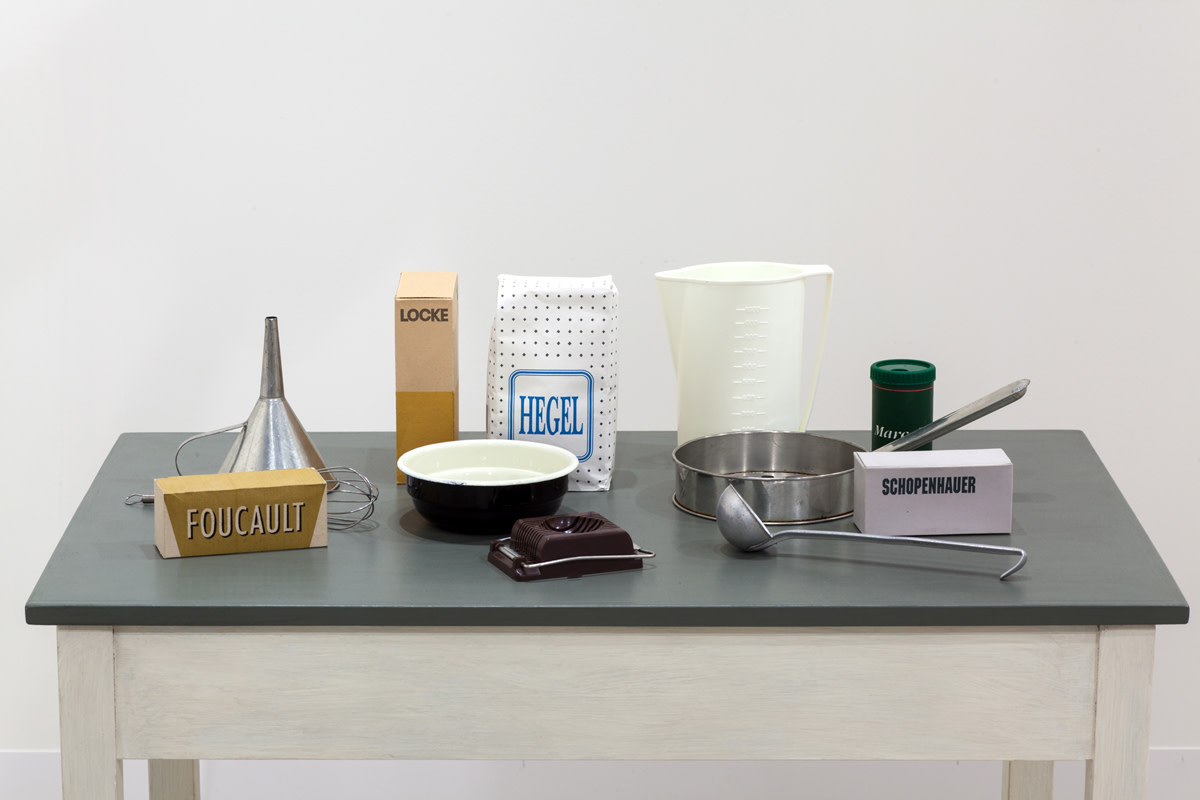
| Roman Ondak, Sated Table, 1997 (detail), silkscreen print on cardboard, kitchen utensils, wooden table,
100 x 92 x 59 cm
Photo © Simon Vogel | |
|
Hito Steyerl – Numéro art Magazine, out now
|
|
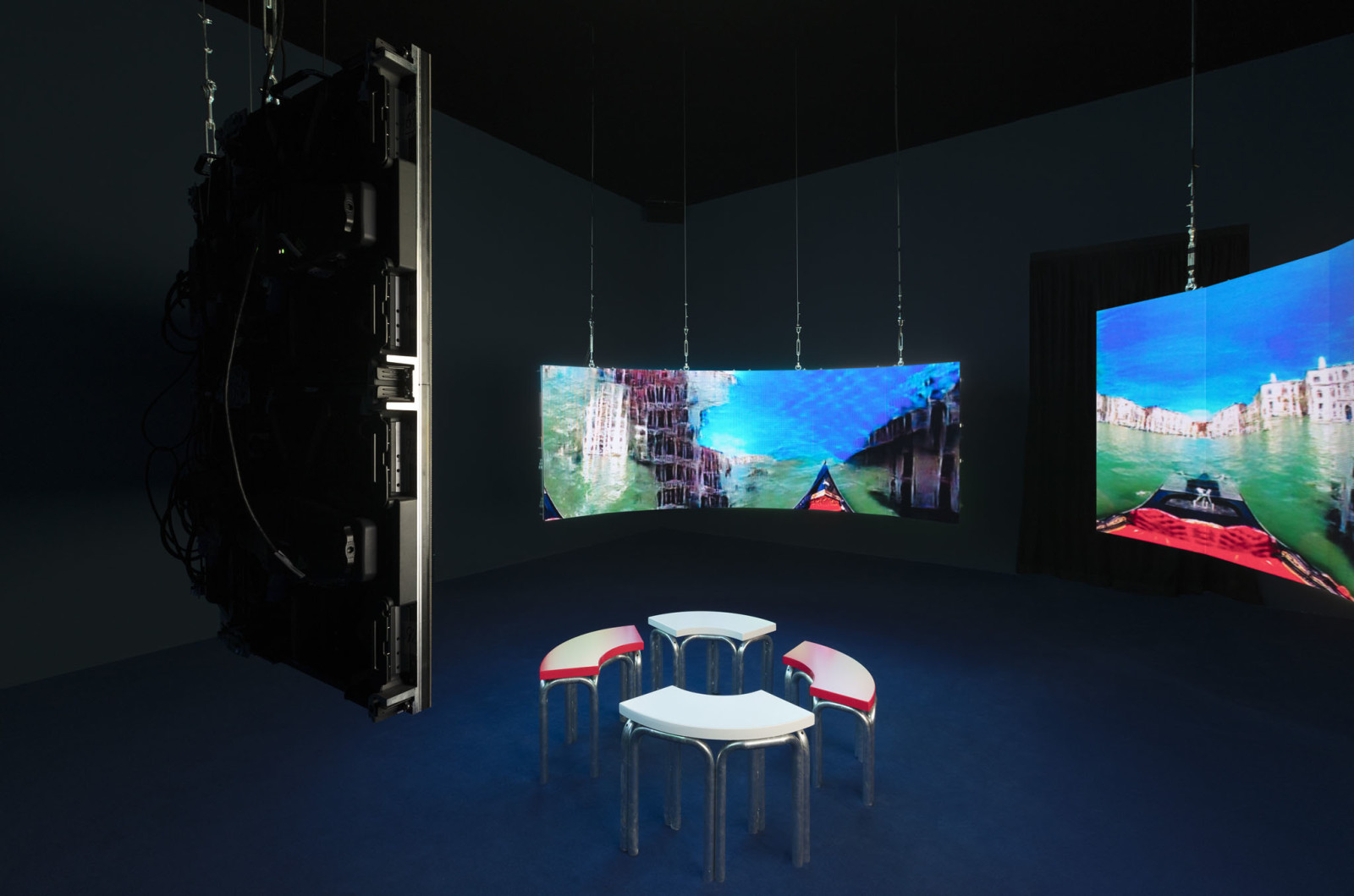 | Hito Steyerl, Leonardo’s submarine, 2019, 3 channel HD video, color, sound, environment: 3 curved screens made of LED panels, dimensions variable, duration: 9:30 min
Exhibition view: May You Live In Interesting Times, 58th International Art Exhibition – La Biennale di Venezia, Venice, 2019
© VG Bild-Kunst, Bonn, 2020
Photo © Andrea Rossetti | |
|
Below an excerpt from Ingrid Luquet-Gad's astute essay on the work of Hito Steyerl, published in the June issue of the French Magazine Numéro art, on newsstands today.
(....)
While today most people know Steyerl’s work for its formidably efficient aesthetic, were we to consider her once again as a documentary filmmaker it would allow her to be saved from the danger of being reduced simply to an artist of the post-Internet years. Because Steyerl is not an Internet artist, she is an artist of networks, which is to say structures and infrastructures. Under the glossy varnish of today’s new media, she exposes the military-industrial complex that is behind the development of the technologies we all now use, technologies which encrypt our perception of the world and threaten not just to undermine but even to replace our established democratic institutions.
We are all now aware of this, as scandal after scandal reveals the extent to which the funding of most big Western art institutions is stained with blood, such as the recent high-profile cases denouncing patronage by the Sackler family (whose firms are behind the opioid crisis) or Warren B Kanders (whose companies manufacture weapons). At the dawn of a new decade, Steyerl’s is one of the voices that matters, having slipped without apparent rupture between the folds of the current revival of institutional criticism. Her questioning of artificial intelligence and smartphone applications (Leonardo’s Submarine and This is the Future, shown at the 2019 Venice Biennale) constitutes a new line of attack that adds a further dimension to her life-long project, the task that she has relentlessly pursued: making sure that digital technologies cease to serve the powerful who created them and instead become what many believe them to be already, neutral tools at the service of civil society. |
|
|
Simon Fujiwara
Hope House
Publisher: Kunsthaus Bregenz
Language: German / English
Available here
|
|
|
Roman Ondak
History Repeats Itself
Publisher: Walther König
Language: Danish / English
Available here
|
|
|
|
|